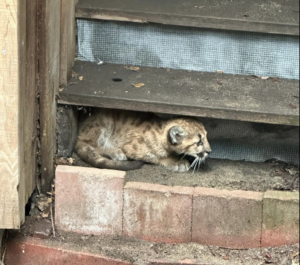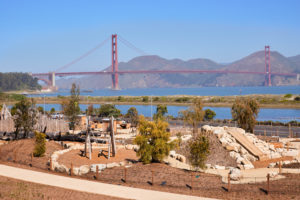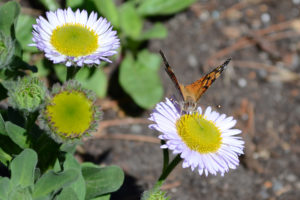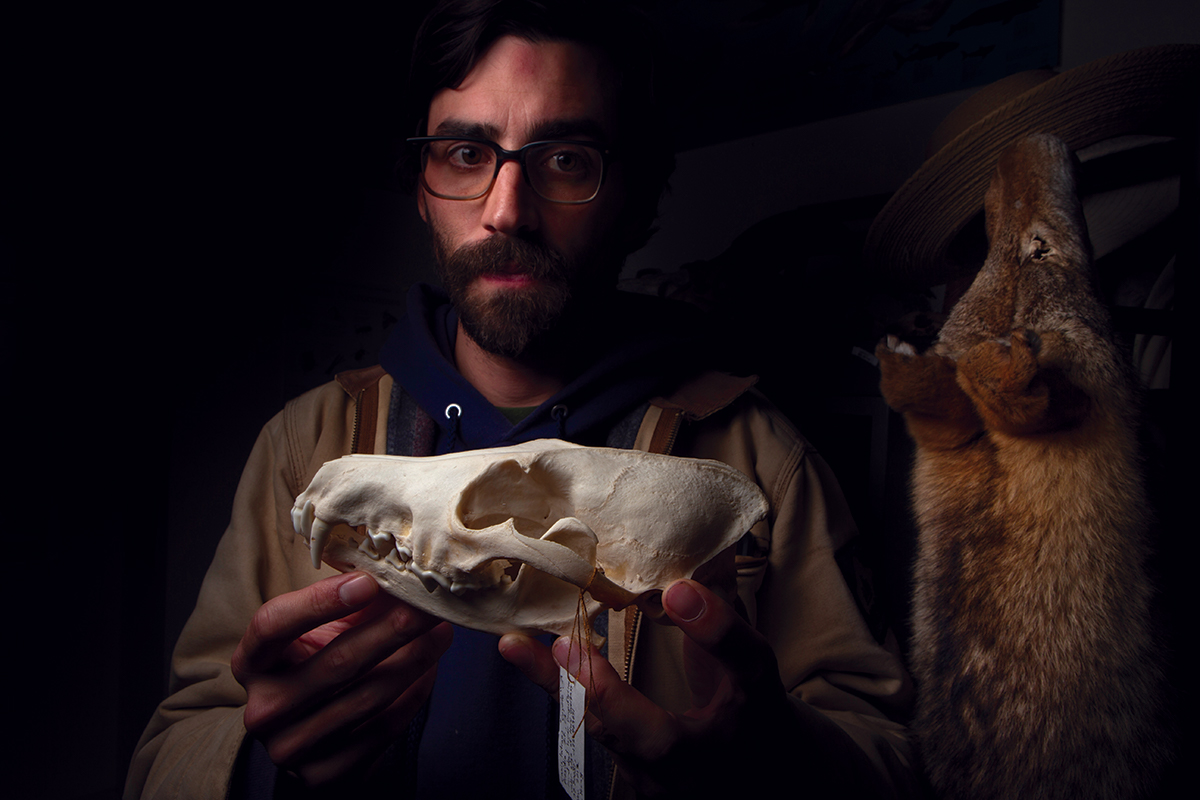
One night a little more than a year ago coyote 02M took off into the dark.
He’d been born in the Presidio, San Francisco, likely a year and a half before, in an earth den dug under a log and hidden by English ivy or in the pit left by a windfall cypress. For months he wriggled in a mass of brothers and sisters, playing and fighting, waiting for his parents to show up with a nice dead rat. Then, a bit older, he scampered through the landscape of palm trees and cream-colored buildings with red-tile roofs, the smells of ocean and hot pavement, learning to listen for the scratchings of gophers underground and to catch his own. But for the past while, he’d been restless. Pale, with stilt legs, enormous ears and an anxious expression—the picture of a gangly adolescent—he was old enough to want his own territory and a mate. The unease pushed him down to Lands End and back, long-distance pacing.
And now it was time to go.
Heading south, 02M left the restored meadows and eucalyptus forest for the habitat of Home Depot and In-N-Out Burger. During the day he’d hide and sleep, then at night he continued on, parallel to the highway, poking around Millbrae and San Mateo, exploring the manicured fantasy of the Stanford campus. But he kept moving, sniffing around the backyard pools of Los Gatos, until he ended up at Highway 17. Loping along the edge of the road, as he’d done for miles already, would take him into the Santa Cruz Mountains, with its acres of tall redwoods and deep shade, a larger stretch of wild land than he’d ever seen.
Maybe mountain coyotes chased him off. Or maybe he just felt more comfortable with the tinge of exhaust and mowed lawns that reminded him of home. Either way, he circled back and gravitated toward a swirl of off-ramps and on-ramps where 280 met 85, living off mice and voles he found in the dry grass and trash on the side of the freeway.
When Jonathan Young, the Presidio Trust ecologist who’d been watching satellite data from 02M’s GPS collar trace across his computer screen in the Presidio, saw where the coyote was hanging out, he had a sinking feeling. Sure enough, a few days later, California Fish and Wildlife called: “We’ve got your animal.” 02M had been hit by a car and killed.
Coyote 02M was one of seven coyotes living in the national park that Young and others radio-collared in 2016, hoping to see how they interact with each other, avoid or approach humans, navigate city life. In the spring, they trapped the alpha female and a one-year-old—02M. Then, in the fall, they caught five pups born that year. They took blood samples, tissue samples, hair and whisker samples, and anal, ocular, and nasal swabs, collecting a wealth of information about DNA, dietary habits, overall health. Then they attached a tracking collar, so the animals could be followed, and a colored tag in each ear, so they could be identified through binoculars.
Though coyotes have been back in San Francisco since at least the early 2000s, this is the city’s first radio-collared population. And ecologists like Young hope that in addition to providing a trove of scientific data, the collars will help two toothy, intelligent species share the dense streets of the city. “My goal as a manager here is to minimize, to the extent possible, conflict between humans and coyotes,” he says. It’s not the easiest task.
All over the country, predators are returning. The 20th-century government campaign to rid the country of large carnivores by shooting, poisoning, and trapping has, for the most part, stopped. The results—exploding prey populations, species on the brink of extinction—were deemed too damaging, the philosophy of predator extermination misguided. In some cases, carnivores are escorted back in cages in planes or trucks, like the wolves brought to Yellowstone in the 1990s, or swift foxes released on the Blackfeet Reservation in Montana. In still others, though, they invited themselves in.
But none has made itself as welcome as quickly—and as deep in the urban core—as the coyote.
In New York City, they scavenge outside the jail at Rikers Island. They birth pups in concrete dens by Chicago’s Soldier Field. They lope down streets at night in Los Angeles, skyscrapers glowing in the background, and trigger home security cameras in Houston. And in the Bay Area, one cocks an ear and lets a car pass near Telegraph Hill. Another paddles in the pool ruins of the Sutro Baths. Estimates suggest a San Francisco population of between 50 and 100.
As Dan Flores argues in his 2016 book Coyote America, human alterations of the landscape may benefit coyotes in all kinds of unexpected ways. Perhaps, he writes, coyotes are not in the city despite humans but because of them. In this, they are like house sparrows and starlings, who don’t just tolerate a landscape of stoplights, strip malls, and potato chips. They like it. We aided coyote expansion of their range over the past 500 years, Flores argues, from the core in the interior West as they went south to El Salvador, chasing flocks of domestic sheep; north to the Arctic Circle, following miners; then east to the coastal states that we’d graciously cleared of coyotes’ main competition: wolves. We constantly create more habitat for an animal known for being curious and adaptable. And now they are following bridges, highways, and railroad tracks into the downtown shopping district.
And the question arises—now that they’re back and predator slaughter is out of fashion—how do we live with them?
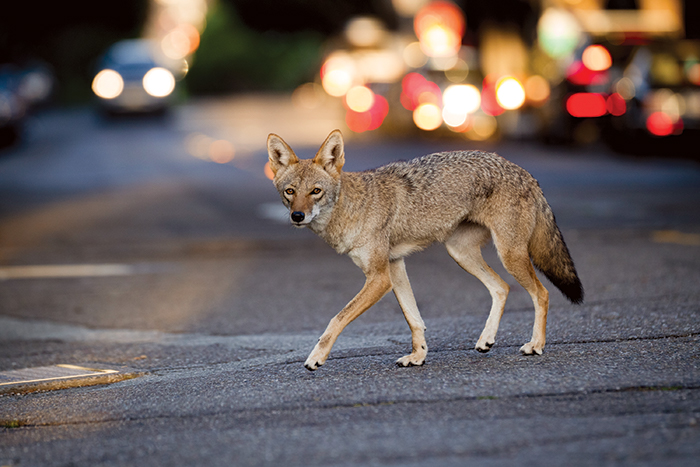
In Young’s office at the Presidio Trust, a coyote pelt hangs on a coatrack, along with a ranger hat. A poster lauding “weevils of the micro wilderness,” a shed snake skin, and a taxidermied bat in a box decorate the walls. Sitting in the midst of this miniature natural history museum, Young shows me 02M’s plastic radio collar, battered and gnawed.
Young, who has black shoulder-length hair and black plastic-rimmed glasses, wears a ranger beige Carhartt jacket and pants. A Southern California drawl, a bit of the surfer, belies the intensity with which he talks about coyotes. He grew up in the suburbs of Los Angeles, near the Angeles National Forest, where coyotes never left. Neighbors knew coyotes lived close and they took precautions: “if you leave your cat outside and it doesn’t come home, you know it either got hit by a car or a coyote or a raccoon.”
But San Francisco is different. Before the recent resurgence, coyotes had been absent for decades, and most residents, unaware of their presence, don’t expect one might show up in their garden or along a favorite jogging route. Those who want their city wild-animal-free and those who work for organizations like Project Coyote, whose mission is to “promote coexistence between people and wildlife,” live next door to each other. And while coyotes are considered pests in many places, here Young is charged with their protection. This relies on the good opinion of a public who doesn’t know much about them. One bite, and it could slip away.
Almost immediately, radio collars helped dispel rumors that swirled around the coyotes like morning fog. Before the tagging, no one had any idea how many lived in the park. But the collars showed the Presidio didn’t host hundreds, only one breeding pair and their offspring. The coyote hordes that observers reported were often the same animal, seen over and over. A coyote out mid-day didn’t mean it was sick, only that it might be prime time for sunning oneself.
The collars also allow researchers to see where the coyotes are and head off trouble before it starts. During the day, Young tracks the collared animals on foot or in his truck by following the radio signal. At night, he uses the GPS and follows them remotely. Their wanderings leave bright lines all over his computer-screen map, covering the park so completely, the map looks like a kid scribbled all over it with a crayon.

One morning in March, Young winds through the Presidio in a pickup truck, past trails and bike paths, past a fresh restoration project, muddy and raw. He’s let me tag along. The alpha female is pregnant, and the dens are potential sources of tension; coyotes, shy at other times of the year, chase off dogs who come near, snarling and frightening their owners. If Young can find the den, he can warn visitors away by posting signs. He’s gathering clues—tracks in the dirt near a good water source, a promising lack of raccoons—but for now, it’s still a mystery.
Scrambling down a slope of downed eucalyptus, footsteps squeaking on the carpet of ice plant, we move through a forest bound together by blackberry, checking on a former den site. Several years ago, as Young was searching for dens, he was walking this trail when a pup tottered right in front of him. Behind it, he saw the birthing den—the hole left by the roots of a toppled tree. Young points out a camera trap strapped to a dead trunk. It’s one of many in this area, and when the den was active, his phone was blowing up with constant text message pictures of pups: tumbling over each other, eating a gopher, gnawing a deflated football. But today all is quiet; the coyotes hatch their plans elsewhere.
Like denning, dispersal is another fraught activity, as 02M’s story shows. As young coyotes strike out on their own, moving through unfamiliar terrain, the likelihood of encountering humans increases, often with fatal results. One radio-collared young male died in Daly City in a backyard full of trash. Another ended up dead in Golden Gate Park and, like 02M, probably got hit by a car.
Young and I stop at the base of a hillside covered with wet grass and wild iris, to listen for the radio signal of another itchy young male, 04M. The sun is just coming up over the eucalyptus at the crest, as Young puts the antenna out the truck window and turns on the tracking radio. In a dispersal attempt a month before, 04M wound up at a Russian Hill apartment complex, cowering in a backyard, under a bush. Animal control caught him and brought him back to the Presidio. Now 04M often spends his days hanging out on this slope, lounging or hunting gophers, keeping to himself, maybe waiting for another chance.
Faint pings from the telemetry equipment indicate 04M is still in the park. He’s close, just not right here. After a night of roaming, coyotes often rest during the day, making them hard to see. We back the truck down the path and park nearby, in a neighborhood of small houses. Young takes out his binoculars.
“You would probably not notice that guy right there. He looks like a rotten log,” Young says and points to a patch of grass by a telephone pole. Nearby, kids scramble over a pile of wood chips; a man in jogging shorts sprints down a hill. Then a coyote, 04M, materializes, curled in a ball in the shade of a nearby acacia. The telemetry equipment has revealed him, not far from the sidewalk. He’s mottled gray and brown with a black-tipped tail and long snout. At the pinging, he lifts his head, ears flat, and lazily opens one eye. Spending a lot of time on his own, separate from the main pack, he might be still hankering to disperse. But this morning, he’s just biding his time, hidden in plain sight.
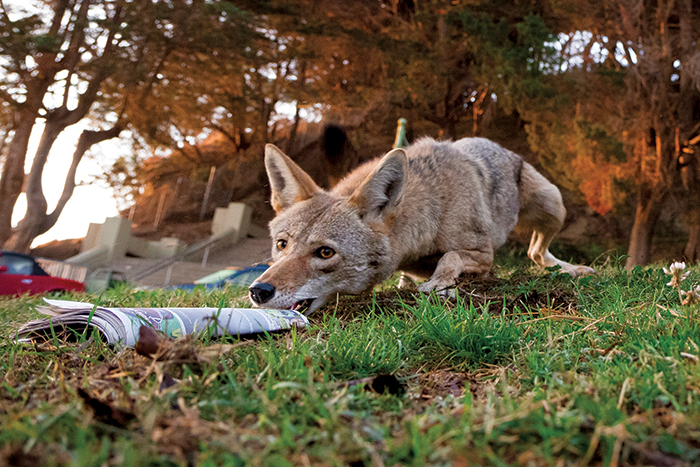
In September of 1917, a notice appeared on the house of colonel Charles H. Blinn on Edgewood Avenue:
“Owing to the reappearance of the ‘Lone Wolf of Sutro Forest’ in our neighborhood, and to allay the fear of parents in safeguarding their children and chickens, this call is issued to the men of this district. You are ordered to report at this post Sunday, September 9, at 4 a.m., prepared to capture this wild animal. Bring your arms and ammunition.
(Signed)
Hunt Committee”
Then, nine years later, on the day before New Year’s Eve, the police got a predawn call from a woman who said “Timber wolves!” Then again, “Timber wolves from Sutro Forest!”
“You better go back to bed, lady,” the officer answered and added, for good measure, “There are no wolves in Sutro Forest.” But her call brought a sergeant to Seymour Avenue in the Western Addition, where a man guarded his basement door against whatever was snarling inside. The police officers opened the door, fired into the dark, and removed the corpse of the coyote, which, the paper speculated, had been searching for a “holiday dinner.” The headline in the Examiner, no less astonished in tone than one that might appear a hundred years later, blared: “Wild West Yet! Coyote Is Shot.”
Coyotes persisted for years in San Francisco, even as it burned and was rebuilt, bridges stretched to Oakland and then Marin, the human population doubled. Throughout the early 20th century, city officials and concerned citizens shot them in Golden Gate Park for preying on deer and near Potrero Hill for eating chickens from backyard coops. They were always there, worrying the fringes of the city, worrying the people who cast a suspicious eye on patches of parkland. And then, eventually, after a sustained campaign of hunting, trapping, and poisoning, they weren’t.
But the city remade itself, cleaning up hazardous waste sites and restoring wet meadows and tidal marshes, and persecution eased in surrounding areas. The goal wasn’t to welcome coyotes back to the city, but that was the result. They came and made a home, without the permission granted our favored predators—dogs and cats—and beyond our control.
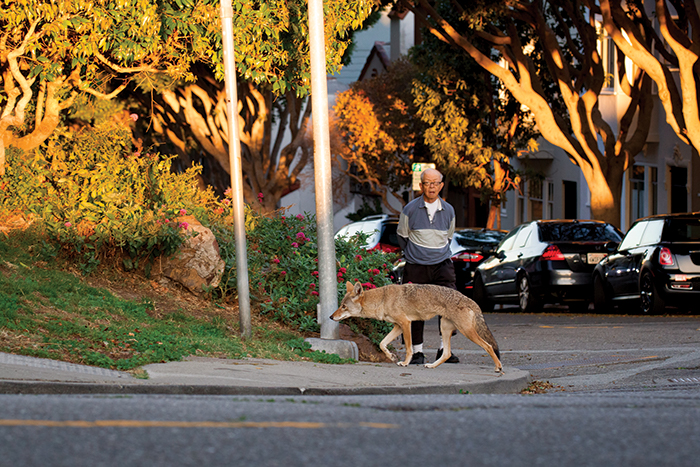
When I next saw Young, he was staring at his phone in horror. It was early June, pupping season, and we were at the International Urban Wildlife Conference in San Diego, supposed to be attending panels on “Landscape and Socioeconomic Predictors of Urban Coyote Distribution: New York Versus Chicago” and “Diet of Coyotes in Southern California at the Urban-Wildland Interface,” but Young was pacing in the courtyard. The Presidio coyotes had chosen a den right near the crowded Bay Area Ridge Trail, and several surrounded a dog. Social media was on fire. Tweets included “Coyote Aggression on Rise, Presidio Dog Owners Claim” and “Snarling coyotes charge dogs, force closure of two trails in SF’s Presidio.” NextDoor app users spread alarm and bad information. The rumors Young spent so much time extinguishing—about hundreds of coyotes haunting the park, about their bloodthirsty nature—flared back to life.
The Wild West crashed into the electronic frontier, and people demanded something be done across all available platforms. The dog owner wanted the coyotes removed. A commenter on a CBS report wrote, “By ignoring the threat of these vermin, these rattlesnakes with legs, City of SF are endangering public safety and putting dogs, cats and children into harm’s way,” and suggested a lawsuit. If that wasn’t enough, not long after, a coyote in Ingleside snatched a Shih Tzu off someone’s front steps.
But the response wasn’t as simple as it would have been a hundred years ago: calling the police or forming a posse. Moving a coyote is illegal in California; no one wants anyone else’s rejects. Animals that are trapped have to be killed. And while throughout the state coyotes can be shot in any season and number, the Presidio is a national park. As native animals, coyotes have as much protection as bison in Yellowstone or bighorn sheep in Glacier. And in the city of San Francisco itself, even beyond the Presidio’s protective boundaries, hunting and poisoning coyotes is prohibited.
Even if the Presidio coyotes could be killed, more would move in to take their place. Radio collars have shown how far they travel, with 02M’s sojourn in the South Bay as only one example. When a coyote popped up in the Presidio in 2003, a researcher took a DNA sample and traced it to a northern population. And Marin County, across the Golden Gate from the Presidio, has an endless supply. They would just need to saunter across the bridge—as coyotes have clearly done before—and settle in.
Cities throughout the country are scrambling to come up with solutions for coyote/human conflict. In Denver, Colorado Parks and Wildlife tries to gauge the most aggressive individuals in a population and shoots them. Austin, Texas, adopted a resolution to promote hazing—making loud noises, hurling sticks, spraying them with a garden hose—so the coyotes stay wary of humans.
For Justin Brown, an ecologist with the National Park Service who tracks coyotes in downtown Los Angeles, the willingness of people to warn off coyotes is key. The collars revealed how close they pass to humans, thriving on tiny habitat patches between construction sites and office buildings.
“Don’t let them get super comfortable with us,” he says. “Most coyotes, even if you do that, they’re not going to become a nuisance, but with the subset of them that are, that’s how we allow them to get that way.”
Many coyotes that turn to trouble have been lured to coyote-lovers’ yards by those who leave out dog kibble, either by accident or intentionally, so one option is increasing fines and enforcement for feeding wild animals. As of now, the fines in San Francisco are $196 in city parks and $1,000 elsewhere. But the challenge, according to Deb Campbell of Animal Care and Control, is catching the feeder in action.
For now, the Presidio has closed trails near the den and posted signs warning dog walkers to stay away during pupping season. As in Austin, the Presidio encourages residents who find coyotes on their lawns to scare them off. Using the collars, Young keeps an eye on their roaming, an uneasy truce.
But the radio-tracking also serves another purpose. In addition to information about behavior, the collars offer a deep look into coyote lives. “There’s all kinds of drama going on,” Young says. “There’s all kind of really crazy, interesting stories that are happening that just otherwise go unnoticed.” Without the satellite data, 02M’s 144 miles up and down the Peninsula and to the edge of the Santa Cruz Mountains would have gone unrecorded: “If this individual wasn’t collared or tagged, it would just be another dead coyote on the side of the road.”
To further shed coyotes’ anonymity, Young and the Presidio Trust use iNaturalist, a web platform where users can make and share observations of wildlife and plants, to encourage the public to submit photos of coyote sightings. With the different colored ear tags for identification, a user can see shots of, say, 06F, 04M’s toast-colored sister, with her double purple tags, as she streaks across the road or lounges on a hillside with her family. Combined with radio collar data, iNaturalist shows she, too, is on the cusp of dispersal, venturing into Golden Gate Park some nights.
Or 04M, the young male who got lost in Russian Hill and had to be extracted from the apartment complex. A photo posted to iNaturalist in late summer showed three coyotes on a street winding up Telegraph Hill: one glancing up at an apartment from the sidewalk, the other loitering in the middle of the road, and a third emerging from yellowed grass. Young recognized 04M among them. The young coyote finally ended up with a female and pups (that may or may not be his) near Coit Tower.
We sort animals constantly: wild/tame, useful/useless, those welcome in the house/those evicted, food/pets. One of the most powerful groupings is those that make us marvel/those that do not. The collars and digital platform offer technology-aided empathy, a way to follow a coyote’s story without chasing or feeding it. As residents mull how coyotes fit into their vision of “San Francisco,” these are potent tools for redefinition, taking coyotes from the category of “vermin” (the place they occupied for most of the 20th century) and edging them into the category of wonder.

